Flat Roof Drainage Issues: What Every Building Owner in Barrie Should Know
- Yellow Pages Admin

- Oct 21
- 3 min read

Flat roofs offer a sleek, modern look and are a practical choice for many buildings in Barrie. But with that style comes a unique set of challenges—especially when it comes to drainage. If not properly managed, water buildup can lead to expensive damage and long-term headaches. In this guide, we’ll break down the most common drainage issues, why a solid drainage system matters, and how to keep your flat roof in top shape.
Why Flat Roofs Aren’t Always Flat—and Why That Matters
Despite the name, flat roofs aren’t completely level. They’re built with a subtle slope to help water flow off the surface. This design helps, but it doesn’t completely eliminate the risk of drainage problems. Here are the most frequent culprits:
Pooling Water: A Silent Threat
When water collects in dips or low spots on your roof, it’s known as ponding. This stagnant water can cause:
Structural Weakness: Over time, trapped water can degrade roofing materials and compromise the building’s integrity.
Mould & Mildew: Moisture invites mould growth, which can affect indoor air quality and pose health risks.
Accelerated Aging: Constant exposure to water and UV rays can wear down your roof faster than expected.
Blocked Drains & Gutters
Leaves, twigs, and debris can clog your drainage system, preventing water from escaping. Without regular cleaning, these blockages can lead to overflow and water damage.
Poor Installation Practices
If your roof wasn’t installed with the correct slope or drainage layout, water may not flow properly. Hiring experienced professionals familiar with Barrie’s climate is essential to avoid these issues.
Drainage Done Right: What Your Roof Needs
A well-functioning drainage system is the backbone of a healthy flat roof. Here’s what to look for:
Scuppers vs. Internal Drains
Scuppers: These are openings at the roof’s edge that let water drain off the sides.
Internal Drains: Located within the roof, these channel water through pipes to downspouts.
Both systems must be strategically placed and maintained to ensure smooth water flow.
Drainage Membranes
High-quality membranes help guide water off the roof and into the drainage system. These membranes help reduce standing water and preserve the integrity of the roof.
Routine Maintenance
Regular inspections can help identify minor concerns before they escalate into serious damage. Watch for pooling water, blocked drainage, or surface deterioration. Annual checkups by a roofing expert are a smart investment.
Smart Prevention Tips for Barrie Homeowners
Want to avoid drainage disasters? Here are some proactive steps you can take:
Keep It Clean
Remove any leaves, twigs, and debris that may have collected on your roof and in the gutters. This simple habit can prevent clogs and water damage.
Watch for Warning Signs
Leaks, sagging areas, or discoloration could signal drainage trouble. Addressing minor concerns promptly can prevent major financial setbacks.
Choose Durable Materials
Invest in roofing products built to withstand Barrie’s weather. Quality materials are less likely to crack, warp, or fail under pressure.
Call in the Pros
If you’re unsure about your roof’s drainage setup or spot a potential issue, don’t wait. A qualified roofing contractor can assess the situation and recommend solutions tailored to your property.
Final Thoughts: Protect Your Investment
Flat roof drainage problems are more than just a nuisance—they can threaten the safety and value of your property. By understanding the risks, maintaining your drainage system, and seeking expert help when needed, you can keep your roof performing at its best for years to come.


Comments